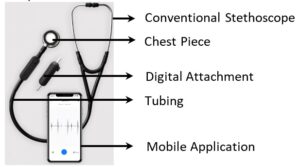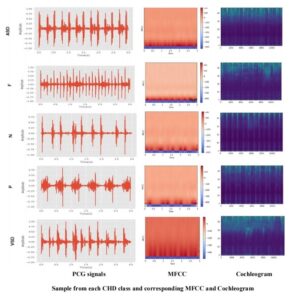Pediatric Heart Murmurs and Disease Diagnosis
An Artificial Intelligence (AI) – based Automated Approach for the Classification of Pediatric Heart Murmurs and Disease Diagnosis using Wireless Phonocardiography
Tags:


Overview
Heart diseases are one of the most frequent causes of infant mortality and morbidity globally. In Ireland, heart diseases are affecting up to 1 in 100 babies born. But a significant proportion of the national caseload in cardiology is accessed through general hospitals and delivered by non-cardiologists because of the limited number of consultant cardiologists. Traditional methods, such as using a stethoscope to detect heart murmurs, rely heavily on a physician’s experience. Although echocardiography is the gold standard for diagnosing CHDs, it requires young children to remain still for 30 to 45 minutes, making it neither feasible nor cost-effective for all suspected cases.

Our innovative solution employs AI to analyse phonocardiogram (PCG) signals, which are recordings of heart sounds captured with a digital stethoscope. The goal is to create an automated system that provides objective interpretations of these heart sounds, complementing traditional methods and reducing the reliance on expensive and time-consuming echocardiograms. This approach aims to make early diagnosis of CHDs more accessible and efficient.
Our research integrates artificial intelligence with PCG analysis to develop a more objective and efficient tool for detecting heart murmurs and diagnosing CHDs. This AI-based system has the potential to enhance diagnostic accuracy, reduce the need for expensive echocardiograms and make early detection more accessible.
This could significantly improve patient care by enabling timely intervention and treatment, ultimately leading to better health outcomes for affected children.
Implementation
The project will work with two pediatric hospitals to collect PCG data through electronic attachments to stethoscopes. The data is denoised and pre-processed to extract relevant features to build an artificial intelligence model for predicting CHD. The researchers then optimize the model to improve its overall performance. At the same time, the project will also build a corresponding web-based application to improve its industry usability. PCG signals, combined with the power of artificial intelligence (AI), can provide an objective interpretation of heart sounds to complement traditional auscultation methods using echocardiography. The study proposes an AI-based automated detection system for heart disease using PCG heart sound signals, which would help doctors and primary care providers make early diagnoses of CHD, rather than putting children directly through costly and lengthy diagnostic procedures.
The innovative technologies involved in the solution include:
- Classification of pediatric PCGs into more than 3 classes using deep learning techniques.
- Use of cochleogram as one of the features for the unpolished pediatric dataset.
- Collection and organization of a large-scale pediatric heart sound dataset.
- Development of a web application for the pediatric heart abnormality detection.
The developed application might not only reduce the time to diagnosis but also potentially reach more children, thereby saving resources and lives. This will be a smart tool in the hands of a GP to easily detect cardiac disorders in children.
Key Objectives
- Classification of heart murmurs into Normal (N), Systolic (S), Diastolic (D), and Continuous (C) murmurs making the disease diagnosis easier.
- Develop an AI-based pediatric heart abnormality detection model using PCG signals that can classify heart sounds into the following categories:
- Normal (N)
- Functional (F)
- Ventricular Septal Defect (VSD)
- Atrial Septal Defect (ASD)
- Other Pathological Defects (P)
- Develop a web-based application for the classification of pediatric heart murmurs and to detect heart abnormalities.
- Collect and organize a large-scale pediatric heart sound dataset.



